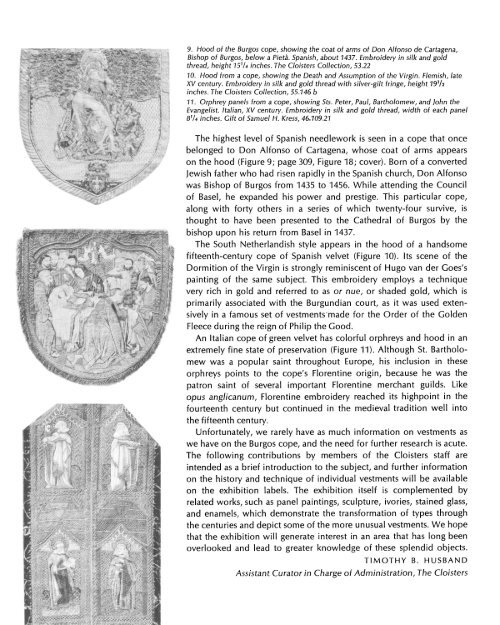The Metropolitan Museum of Art Bulletin, v. 29, no. 7 (March, 1971)
The Metropolitan Museum of Art Bulletin, v. 29, no. 7 (March, 1971)
The Metropolitan Museum of Art Bulletin, v. 29, no. 7 (March, 1971)
Create successful ePaper yourself
Turn your PDF publications into a flip-book with our unique Google optimized e-Paper software.
9. Hood <strong>of</strong> the Burgos cope, showing the coat <strong>of</strong> arms <strong>of</strong> Don Alfonso de Cartagena,<br />
Bishop <strong>of</strong> Burgos, below a Pieta. Spanish, about 1437. Embroidery in silk and gold<br />
thread, height 151/4 inches. <strong>The</strong> Cloisters Collection, 53.22<br />
10. Hood from a cope, showing the Death and Assumption <strong>of</strong> the Virgin. Flemish, late<br />
XV century. Embroidery in silk and gold thread with silver-gilt fringe, height 191/2<br />
inches. <strong>The</strong> Cloisters Collection, 55.146 b<br />
11. Orphrey panels from a cope, showing Sts. Peter, Paul, Bartholomew, and John the<br />
Evangelist. Italian, XV century. Embroidery in silk and gold thread, width <strong>of</strong> each panel<br />
87/4 inches. Gift <strong>of</strong> Samuel H. Kress, 46.109.21<br />
<strong>The</strong> highest level <strong>of</strong> Spanish needlework is seen in a cope that once<br />
belonged to Don Alfonso <strong>of</strong> Cartagena, whose coat <strong>of</strong> arms appears<br />
on the hood (Figure 9; page 309, Figure 18; cover). Born <strong>of</strong> a converted<br />
Jewish father who had risen rapidly in the Spanish church, Don Alfonso<br />
was Bishop <strong>of</strong> Burgos from 1435 to 1456. While attending the Council<br />
<strong>of</strong> Basel, he expanded his power and prestige. This particular cope,<br />
along with forty others in a series <strong>of</strong> which twenty-four survive, is<br />
thought to have been presented to the Cathedral <strong>of</strong> Burgos by the<br />
bishop upon his return from Basel in 1437.<br />
<strong>The</strong> South Netherlandish style appears in the hood <strong>of</strong> a handsome<br />
fifteenth-century cope <strong>of</strong> Spanish velvet (Figure 10). Its scene <strong>of</strong> the<br />
Dormition <strong>of</strong> the Virgin is strongly reminiscent <strong>of</strong> Hugo van der Goes's<br />
painting <strong>of</strong> the same subject. This embroidery employs a technique<br />
very rich in gold and referred to as or nue, or shaded gold, which is<br />
primarily associated with the Burgundian court, as it was used extensively<br />
in a famous set <strong>of</strong> vestments'made for the Order <strong>of</strong> the Golden<br />
Fleece during the reign <strong>of</strong> Philip the Good.<br />
An Italian cope <strong>of</strong> green velvet has colorful orphreys and hood in an<br />
extremely fine state <strong>of</strong> preservation (Figure 11). Although St. Bartholomew<br />
was a popular saint throughout Europe, his inclusion in these<br />
orphreys points to the cope's Florentine origin, because he was the<br />
patron saint <strong>of</strong> several important Florentine merchant guilds. Like<br />
opus anglicanum, Florentine embroidery reached its highpoint in the<br />
fourteenth century but continued in the medieval tradition well into<br />
the fifteenth century.<br />
Unfortunately, we rarely have as much information on vestments as<br />
we have on the Burgos cope, and the need for further research is acute.<br />
<strong>The</strong> following contributions by members <strong>of</strong> the Cloisters staff are<br />
intended as a brief introduction to the subject, and further information<br />
on the history and technique <strong>of</strong> individual vestments will be available<br />
on the exhibition labels. <strong>The</strong> exhibition itself is complemented by<br />
related works, such as panel paintings, sculpture, ivories, stained glass,<br />
and enamels, which demonstrate the transformation <strong>of</strong> types through<br />
the centuries and depict some <strong>of</strong> the more unusual vestments. We hope<br />
that the exhibition will generate interest in an area that has long been<br />
overlooked and lead to greater k<strong>no</strong>wledge <strong>of</strong> these splendid objects.<br />
TIMOTHY B. HUSBAND<br />
Assistant Curator in Charge <strong>of</strong> Administration, <strong>The</strong> Cloisters

















